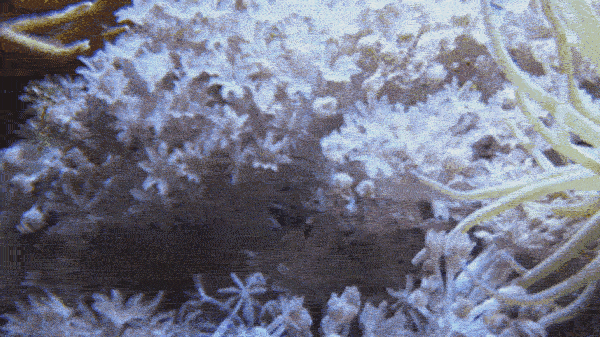The pulsing Xenia has been a scientific mystery for that last 200 years since it was first discovered by Jean-Baptiste Lamarck (1744-1829). Why does this particular coral spend so much energy pulsating? Corals are extremely efficient organisms and do not waste energy unless there is compelling enough benefit — in this case nutrients.
Why does the Heteroxenia fuscescens go through all that fuss? Seems like a lot of wasted energy doesn’t it? Recent research by a team of scientists from the Hebrew University of Jerusalem and the Technion-Israel Institute of Technology finally have a few answers released in a recent issue of the Proceedings of the National Academy of Sciences.
The team discovered the motion of the polyps helps with binding of carbon dioxide to the photosynthetic enzyme RuBisCo (Ribulose-1,5-bisphosphate carboxylase oxygenase), while also decreasing photorespiration. This led the team to the conclusion that in the case of H. fuscescens, the benefit overcomes the cost. Because of the pulsation, the ratio between photosynthesis to respiration in this Xenia is the highest ever measured in stony and non-pulsating soft corals.
We know corals rely on water flow to deliver nutrients and organisms also alter the flow around them as well. By studying the flow around Xenia colonies, the team used an underwater measuring device called PIV (particle imaging velocimetry). This allowed the team to record highly accurate measurements of the flow field around the Xenia in their natural habitat at night.
Through the data provided, the team discovered the motion of the polyps sweeps water up and away from the coral tissues and into the surrounding water. If you’ve ever been entranced with the pulsing motion of the Xenia, you’ll recall that the polyps do not pulse in a synchronized motion. Despite this, the overall result for the colony is significantly enhanced flow that helps reduce the chance of refiltering the same water.
Armed with new data and the hypothesis that the pulsation motions enhance the coral’s photosynthesis rate, the team was able to get clearance from the government to harvest a few colonies for experiments in the lab.
The zooxanthellae in corals requires CO2 during the day and oxygen at night as well as other nutrients (like phosphate and nitrogen) all day. Now it makes sense that coral colonies would want to increase the concentration of these essential commodities around them by being able to mix the ambient water.
But again, why would the Xenia use so much energy just to mix the water? The team measured the photosynthesis rate of the pulsating Xenia colony was found to be an order of magnitude higher than when it is at rest. The researchers increased the oxygen levels in the tank so as the corals pulsated and mixed the water, instead of pulling in CO2-rich water they were pulling oxygen-rich water into the colony. The team found out that when the higher oxygen levels led to low photosynthesis rates — just as if the coral was at rest — proving their hypothesis.
One other interesting observation was the pulsing Xenia pump continually only taking a daily half-hour break in the afternoon. This is still one mystery the team was unable to unlock.
[via Science Daily]



